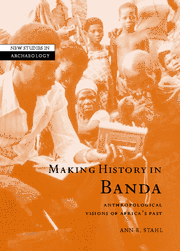Book contents
- Frontmatter
- Contents
- List of figures
- List of plates
- List of tables
- Preface
- 1 Refracted visions of Africa's past
- 2 Envisioning Africa's lived past
- 3 The past in the present: history-making in Banda
- 4 The political-economic context
- 5 Local life in the context of the Niger trade c. 1300–1700
- 6 The changing social fields of Banda villagers c. 1725–1825
- 7 The changing social fields of Banda villagers c. 1825–1925
- 8 Reflections: historical anthropology and the construction of Africa's past
- Notes
- References
- Index
- Other books published in the series
3 - The past in the present: history-making in Banda
Published online by Cambridge University Press: 22 September 2009
- Frontmatter
- Contents
- List of figures
- List of plates
- List of tables
- Preface
- 1 Refracted visions of Africa's past
- 2 Envisioning Africa's lived past
- 3 The past in the present: history-making in Banda
- 4 The political-economic context
- 5 Local life in the context of the Niger trade c. 1300–1700
- 6 The changing social fields of Banda villagers c. 1725–1825
- 7 The changing social fields of Banda villagers c. 1825–1925
- 8 Reflections: historical anthropology and the construction of Africa's past
- Notes
- References
- Index
- Other books published in the series
Summary
The men who deposed the Banda paramount chief in November 1996 had history on their side, as did those who opposed his installation. History, in the sense of knowledge about the past, is ever present and invoked in support of present actions in Banda. Competing factions in the chieftaincy dispute marshal different historical visions, struggling over the primacy of a rotational principle and the role of different families in a distant past (cf. Lentz 1993). Thus history is intensely negotiated, with significant consequences in the present – a kind of “workshop history” (Cohen and Odhiambo 1989:30). Some argue that knowledge about the past is mere discourse, positioned, contextual, and constructed, and not necessarily grounded in a lived past. For social anthropologists interested in asking “How did the present create the past?” (Chapman et al. 1989; Tonkin 1992), rather than the more typical formulation “How did the past create the present?”, the idea of a past constructed in the present is perhaps a comfortable position. But this academic stance is as arrogant as the positivist history that it critiques, for it treats as irrelevant the lived past – the everyday practices and struggles of people to make a life for themselves and their families through changing circumstances. While we must be attentive to how the past is created in the present, we should retain a focus on how the everyday practices of the past created the present.
- Type
- Chapter
- Information
- Making History in BandaAnthropological Visions of Africa's Past, pp. 41 - 81Publisher: Cambridge University PressPrint publication year: 2001

